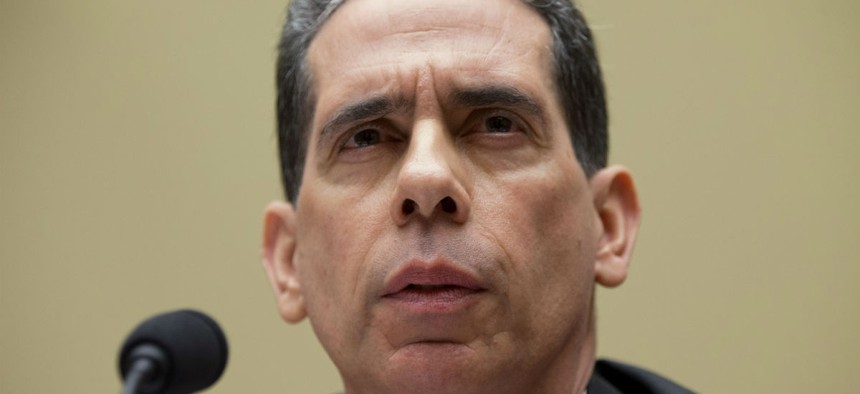
Homeland Security Undersecretary Rafael Borras testifies on Capitol Hill in March 2013. Associated Press file photo
Don’t Blame the Budget for Agencies’ Lack of Innovation
Rafael Borras talks modernization, performance management from his new post at A.T. Kearney.
After four years as chief management officer at the Homeland Security Department, Rafael Borras had tired of the grind of continuous budget uncertainty, public duties and the feeling that no time was ever right to take vacation.
So in February 2014, the undersecretary stepped down after more than 30 years of government experience. After some time spent traveling with his wife, he began working with the management consulting firm A.T. Kearney as chief strategy officer. On June 18, Kearney announced that Borras had joined the global firm as a partner in its federal civilian practice, based in Arlington, Va. In a wide-ranging interview with Government Executive, he opined on a range of DHS management issues and explained his fascination with taking things that work in the commercial world and bringing them to the public sector.
TSA Challenges
Regarding the recent leaked inspector general report showing the Transportation Security Administration’s poor performance in airline passenger screening, Borras echoed DHS Secretary Jeh Johnson and retired TSA Administrator John Pistole in characterizing TSA’s performance as “dismal.” He praised Johnson for “taking swift and decisive action” in replacing the acting administrator, Melvin Carraway, with Acting Deputy Director Mark Hatfield. But Borras added that TSA as a whole “worked hard during my tenure to get both the people and technology issues right. They are very committed men and women who wear the TSA uniform and conduct the screening, which makes these findings all the more disappointing.”
Financial Management
Borras, a veteran of the General Services Administration, Commerce Department and deputy city manager positions in Hartford, Conn., and New Rochelle, N.Y., is more complimentary of Homeland Security’s recent clean audits of two of its annual financial statements. “This success of the financial management community is one of the things I’m most proud of in my tenure,” he said. “To galvanize around a committed goal of a clean audit was a difficult test departmentwide. Our goal was that it not be a one-time achievement but for it to be sustainable and repeatable progress—in perpetuity.” That feat also narrowed the management issues DHS must grapple with to get off the high-risk list compiled by the Government Accountability Office, Borras added.
Shared Services
Borras applauded the Office of Management and Budget’s efforts to push agencies toward adopting more shared services in financial management and human resources. “The discussion has come and gone in cycles for 20 plus years, but now we find a lot of energy and support within the administration and Congress,” he said.
Examples of DHS implementation can be found at the Coast Guard, TSA, the Domestic Nuclear Office and the Office of Health Affairs, which are moving core financial systems over to the Interior Department. Commerce is slightly less far along in shared services in procurement, Borras noted. “To implement it, you have to not only improve service delivery but also improve the cost structure.”
Addressing fears by some in government that shared services will mean reductions in staff, Borras said, “Labor is a big part of delivery of services, so it’s inevitable you face question of deriving cost savings from restructuring labor.”
Acquisition Reform
Borras also praised GSA’s efforts to streamline federal purchasing through “category management” -- the creation of 10 super categories of commonly purchased items. Acquisition reform, information technology, core management areas, “those are basically my life’s work,” Borras said. “What I want to do is contribute to the broader conversation about how the federal government can successfully implement category management, deciding which are the right categories, how to start, how to measure success,” Borras said. “It does no good to implement it if you cannot define the outcomes you’re looking to achieve.”
The creative tension between the public and private sectors is squarely in Borras’s wheelhouse. “There’s a dichotomy in the great desire for government to behave more like a business and its inability to successfully adopt commercial best practices,” he said.
Corporate America, he noted, has been struggling with the same management issues as the government -- IT procurement, talent management, the move to the cloud and more digital services.
Borras doesn’t buy the notion that federal employees are constrained in their ability to innovate while their commercial counterparts supposedly have free rein. Given tight budgets, agencies “have to begin asking very difficult questions, to think differently about how to achieve sustainable growth from innovation,” he said. “We can’t expect Congress to provide additional resources to be innovative and to modernize the federal government.” That means there is a new incentive to innovate, he said.
Private sector CEOs “don’t talk about how we can get something 40 percent right,” he said. “They talk about how we can consistently deliver winning products and services. That mindset has to be instilled in federal leaders.”







